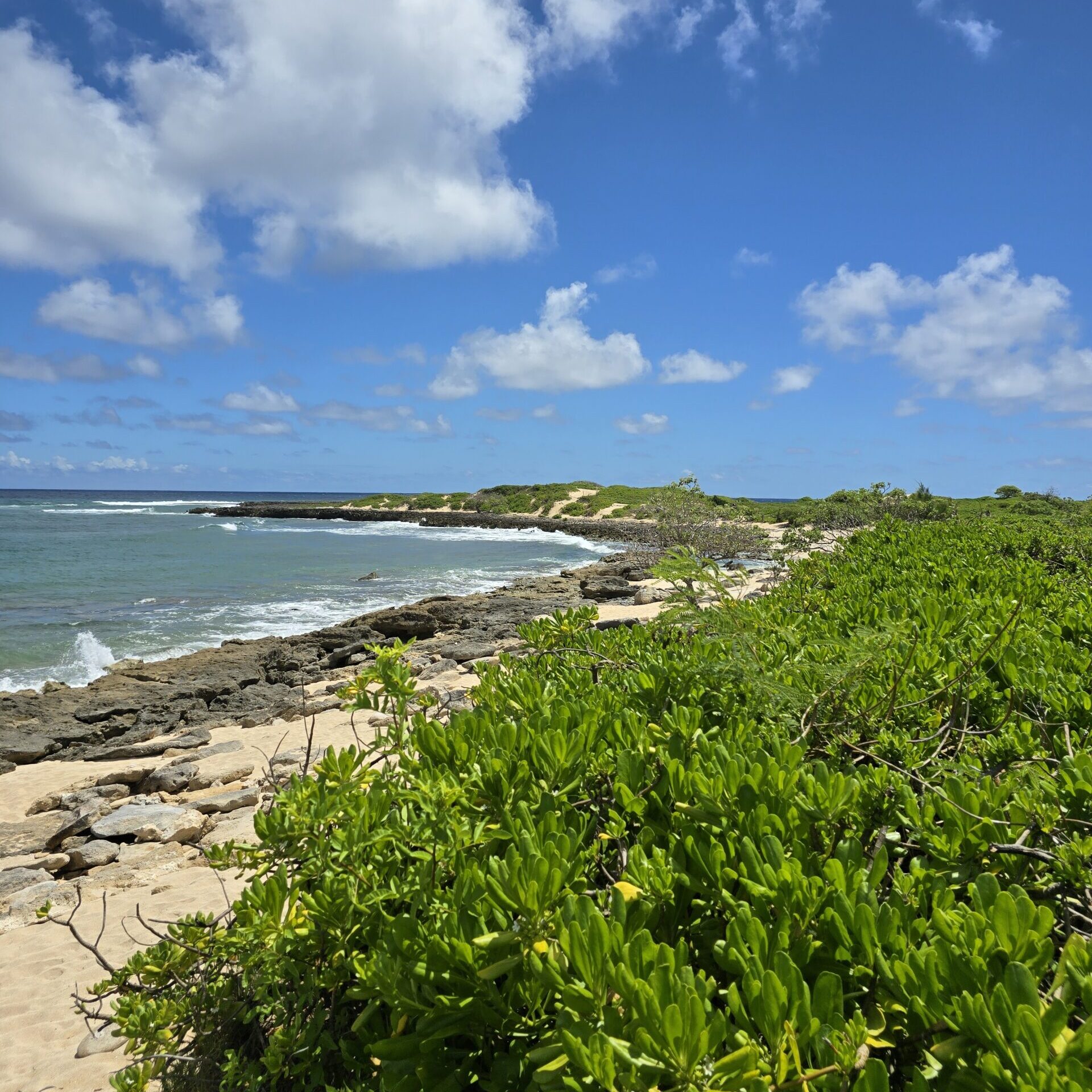our process &
vision for shoreline rehabilitation
Primary Dune Formation
To re-establish a healthy dune system and coastal strand ecology to support shoreline resiliency, reduce erosion and to provide habitat for wildlife to thrive. To provide public beach access and provide educational opportunity that is sensitive to the coastal ecology, and creates distinct access points to the beach zone.
The primary dune is a critical part of the coastal strand ecology and creates a resilient shoreline that protects the property and infrastructure from inundation and erosion damage. A healthy dune system provides habitat for unique coastal flora and fauna, and are naturally resilient, able to adapt to storm waves, high winds, and high tides. The primary dune formation is to be preserved, restored and enhanced with no significant impact to the existing ground surface or change in grade.
View toward Kahuku Point
Ironwood trees degrading the coastline
Ironwood Tree Impact on Shoreline
The existing, invasive Ironwood trees are very fast growing and can grow as much as 5-10’ per year. Due to the fast growth, ironwoods have a shallow root system, making is susceptible to falling over in high winds. The ironwoods can prevent the growth of ALL other plants in their understory and can alter the structure and composition of native ecosystems. Dense growth of ironwoods along coastal strands can interfere with the nesting habits of endangered sea turtles and seabirds.
OUR PROCESS FOR REMOVING INVASIVES AND PLANTING
The process is anticipated to follow the sand dune rehabilitation methods outlined in the Forest Management and Sand Dune Restoration Plan prepared for Turtle Bay Resort properties. A brief summary of the method and goals is provided below:
Invasive Tree/Shrub Removal:
1. Remove invasive ground covers, shrubs and trees. Invasive species should be properly identified by a qualified landscape contractor or arborist.
2. Ground covers and shrubs to be removed through selective use of construction equipment to masticate and rake the material into a fine mulch
3. All mulched debris should be carefully gathered and removed, with limited impact to the surface grades, no digging, cutting or filling is allowed.
4. Large trees should be removed by felling the tree and then cutting the stump to within ~12” of the existing grade, without disturbing the ground surface.
5. Trunks and branches should be stockpiled and hauled, working with the Owner for location of storing and stockpiling material.
6. Stumps should be left in place and not turned over, removed or otherwise cause disturbance to the ground surface.
7. No trees over 15’ tall shall be felled within the Hoary Bat pupping season.
8. All clearing efforts should be managed to provide a safe zone around clearing effort with signage and trail diversions if necessary
Rehabilitation Planting
1. Plants used for rehabilitation should be limited to plants outlined in the Forest Management and Sand Dune Restoration Plan and should be sourced from plant growers or nurseries who have propagated plants from the Kahuku region. Plants should arrive on-site clean, visibly free of weeds, pests, and pathogens. Rehabilitation efforts should take place immediately upon removal of invasive species, with removal scheduled to occur just before the optimal time for planting. Optimal time for planting should overlap the beginning of the rainy season to facilitate establishment.
0-45 days – Passive Rehabilitation
a. All restoration areas should be “roped off” and protected using symbolic fencing to discourage access into the restoration zones
b. Irrigation may be installed if available
c. Limited plantings of Naupaka or other woody shrubs around the remaining stumps may occur
d. The cleared area should be observed every 2-3 days looking for newly germinating plant growing from the seed bank
e. Invasive plants should be identified and immediately removed
f. Any native plants germinating from the seed bank should be identified and protected
45-90 days – Active Rehabilitation
a. Irrigation may be installed if available
b. Restoration planting to be installed in three distinct zones
i. Foredune*– planting in the foredune zone shall consist of “low-lying, loosely bound grasses and vines, such as ‘aki’aki grass and pohuehue and other species that tolerate the natural disturbances that occur close to the constantly changing ocean and beach conditions.”
ii. Dune Crest* – planting in the dune crest zone shall be where the “low-lying grasses and vines transition to, or combine with, low-growing shrubs” and other herbaceous plant such as ihi and ilima.
iii. Mauka Dune (back dune)* – “larger woody shrubs or trees, such as naupaka, milo, or beach heliotrope… are generally found in the back shore, mauka of the dune” planting of these species should limited to this zone.
*Note – for a full schedule of suitable plants, including the suitable location, please refer to the Forest Management and Sand Dune Restoration Plan 2019
Areté team planting at Kahuku Point
Secondary Dune Formation
Rehabilitation of the secondary dune formation should follow the same procedure with the exception that some minor grading and stump removal may take place as long as there are permits in place for clearing & grubbing the area. No earth disturbing activities shall be allowed in areas outside of permitted project areas.
Rehabilitation – Phase 1
Consists of a small area that straddles the western property line of RR3 and is an area where restoration was started a couple of years ago, but has been overgrown with invasive weeds and the native plants have not thrived.
Care and maintenance of this area should include removal of all invasive weeds, installation of irrigation if available, and additional out planting of additional native plants as necessary.
Before
After
Before
After
Rehabilitation – Phase 2
Consists of an area along the RR3 – Phase 1 development areas and includes invasive tree and shrub clearing, passive and active restoration efforts.
Sources:
Turtle Bay Resort – Forest Management and Sand Dune Restoration Plan. December 2019. H.T. Harvey & Associates
Hawai’I Dune Restoration Manual. 2022. University of Hawai’I Sea Grant College Program.







